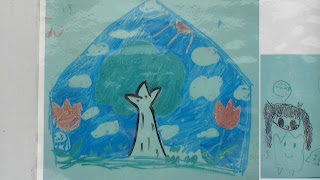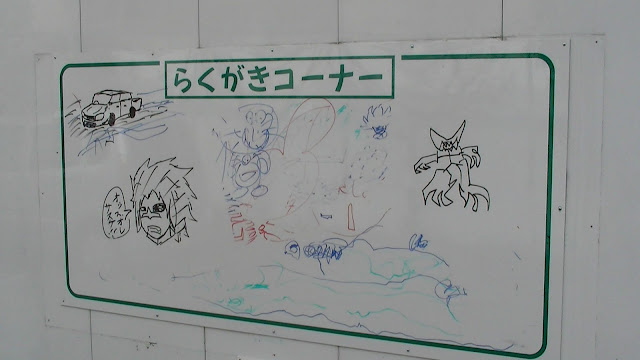...And we are looking at a construction site, because....?
There's been a large construction site next to the elementary school for a year and a half or so now--lots of kids walk by it every day. So you'd expect to eventually see that pristine white wall covered with graffiti...right? Well...sort of. You see something on that wall, right? Here's a closer look:
...that's a nice drawing, isn't it? I liked it--that's why I took a picture of it.
Here's another one:

Awww...carp streamers! And an anime-style girl, both nicely drawn.
Another one I liked...
....a detailed dragon!
Can you see in these pictures that I've taken of the construction wall, that the drawings are not actually on the wall? That is to say, they are not graffiti?
Here's what the kids are actually drawing on:
A white board--there are two of them, in fact. The legend at the top says "Drawing Corner".
Somebody had the brilliant foresight to realize that a looong white wall like that was bound to shout out to kids "Draw on me!", and put up a couple of white boards...
...and whiteboard markers (there are always several markers in different colors), with a sticker on the holder that says "Everybody's Markers".
Ok...so why aren't the whiteboards just filled with rude pictures and words?
Because they take photos of the really good (or cute, in the case of the first graders) drawings and post them permanently on the wall for everyone to see and enjoy. Go look at that top picture again--see all the drawings posted all the way down the construction wall? Kids are kids, so I'm pretty sure not every single drawing is innocent and pure--but the non-offensive good drawings are the ones that get photographed, laminated, and posted.
Somebody is *really* good at drawing Pokemon characters!
...awwww. First graders drawing Doraemon (Gadget Cat from the Future, in blue), and anime-style girly-girls ("I'm Anri!").
I walk by and check from time to time to see if there are new drawings up. Every time I look at that wall, all I can think is--what a smart end run around inevitable behavior! Japanese parents and teachers are incredibly good at positively interpreting what children are doing. They always seem to me to do this instinctively. I've tried to pick up on it. My instinct is nearly always negative--and it leads to arguments or anger or punishment that maybe wouldn't have happened if I'd assumed a positive motive. Kids, for example, like to grab mom's keys. I used to demand that they give them to me (assuming they would lose my keys, or drop them in the toilet, or some such). A much better way to get those keys back? Look as genuinely surprised as you can, smile broadly, and say "Oh! You *found* mommy's keys! Thank you! Mommy was looking everywhere! Thank you!"...all while holding your hand out. Toddlers will look confused, then echo your smile, then drop those keys right into your hand. The same kind of generally positive spin on behavior works with older kids, too. Those white board were a way of saying "Hey! You all draw so well, please come and draw some pictures for us that we can put up! Thank you!"....so the kids came and drew pictures instead of graffiti. It always makes me think of zen master Shunryu Suzuki--"If you want to control your cow, put him in a wide field and watch him." In other words, only by observing and watching first can you know when and how to help or what kind of instruction to offer. I'm not sure, though, whether Japan is infused with Zen ideas, or whether Zen--after coming to Japan--became infused with Japan...
Mata asobou, ne!







that is genius! Seriously, that's one of the smartest things i've ever heard of.
ReplyDeleteAlso, adorable!
OT - i'm making your sesame spinach tonight. I'm excited!
For every post about Japanese parenting you put up, I fall more and more in love with it. The world needs more Japan!
ReplyDelete(I saw a British woman slap her child in the face a few weeks ago. I was so distressed and just wanted to grab the child and run away...)
This is a truly interesting insight! Usually when we talk about Japanese expectations for children, we tend to think of the Tiger Mom (a la Amy Chua, just as one prominent recent personification of this idea)--high expectations that are achieved not through positive reinforcement, but simply by holding kids to a high standard and being disappointed (or worse) when they do not meet that standard. That is, perfection is not hoped for and praised so much as it is expected, while anything less is derided.
ReplyDeleteI'm not sure why we (Westerners) sometimes view (East) Asians as dispassionate taskmasters rather than as loving and supportive parents (I guess people like Chua are part of the reason), but at least based on my own personal experiences, this is a myth. In my high school English classes, my co-teacher and I constantly made use of positive reinforcement and encouragement. I'm sure some aspects of the Chinese Exam-style learning and parenting do survive in modern Japanese society, but it is also nice to acknowledge the times when that is not the case. These ethnographic observations may make our understanding of society more complicated, but this complexity is simply part of a more accurate understanding of the world.
The question of the role of Zen (and other forms of Buddhism) on modern social practices in Japan-including the observe and adapt method to addressing an issue-is both completely beyond my realms of knowledge and experience and highly interesting. There are plenty of scholars of (and books about) modern Japanese society, as well as plenty of scholars of (and books about) (Zen) Buddhism in Japan. I imagine that someone somewhere has adequately addressed the intersection of these two things. I currently don't have access to my full store of books, but if I begin to find an answer, I'll be sure to share!
Sarah--I thought it was smart, too! Very Montessori, actually... Tell me how the spinach turns out!! Hope you like it! (Be sure to squeeze all the water out of the spinach).
ReplyDeletelostinsophistication-- it can be hard to live in a "nail that sticks up will be hammered down" society, but there are positive aspects of it. One of them is the extreme attentiveness to others, and to children. They aren't perfect parents, any more than we are...but many of the things they do are *so* sensible, so... *D'OH!* why didn't I think of that!...that I often think the world needs more Japan, too! (I like how you put that!)
Chris--did you teach over here (JET, or something similar)? Positive discipline practices are widespread--I've seen Adler's books in lots of bookstores. I think his methods are popular because they fit what the Japanese tend naturally to do anyway. I also see many similarities (or convergences) with the Montessori method. I don't think that's an accident--I think these methods work because they get at human universals (I'll have to think about that more to be able to expand on it, though).
ReplyDeleteParents like Chua ("Education Mamas" in Japan--my mother-in-law was one of those) are certainly widespread...but I think people misunderstand and think that the parenting practices she describes and uses with older children are the same as those used with children under six. In spite of Education Mamas--kindergarten in Japan is about socialization. Almost *no* formal ABC/AIUEO learning takes place. "Education is a social problem--not a pedagogical one"--Maria Montessori. That's pretty much how the Japanese approach it, too.
My comments regarding the intersection of Zen and social practices is admittedly based on my own sketchy reading, and my own observations having simply been here for 14 years. But the reading I have done on Zen tends to pop into my head as I watch people, children, social interactions. If you've read Daniel Goleman's "Emotional Intelligence", you'll notice that a number of the examples he gives of "emotional intelligence" came from...Japan. Which didn't surprise me. If you find an interesting read on the wider influence of Zen in Japan--let me know!! I'll read it, too! Arigatou!
the spinach was delicious and a HUGE success! I believe we will be making it ALL THE TIME now.
ReplyDeleteAlso, i was told i need to make more next time.
You rock!
YAY!!! A convert!! *So* glad everybody loved it! And it's totally good for you, too:-)) Make double next time--if there's some leftover, it keeps for a day or two in the fridge, and goes in lunchboxes nicely!
ReplyDeleteooh, good to know!
ReplyDeleteI can sympathise with the problems of living in a "nail that sticks up will be hammered down" society, as Sweden, where I grew up, has a similar philosophy. There, the saying goes that "you shan't believe you are anyone." Though, from my experience, it has the opposite effect to what the nail-analogy seems to have in Japan. Instead of inspiring "altruism," it inspires the opposite: suspicion and paranoia. Though, shall I be fair, maybe Japan is worse afflicted, although the effects in Sweden are far from negligible.
ReplyDeleteI wonder whether Japan and Sweden both being largely homogeneous societies has something to do with that kind of "everyone has to be the same" force? Homogeneity has a positive side, but also drawbacks...
ReplyDeleteI remember a few years after coming to Japan (oh, centuries ago) seeing two very small boys (about four or five, I suspect) who had lost their tempers with each other as they played in the (safe) street and were both fighting and in tears at the same time. Out came an oba-chan (in her sixties, I should think) from one of the houses, dressed in a blue working kimono and apron, and simply moved between the two little boys, saying 'Hora, hora, hora!', pushing one away gently with the backs of her hands and then turning round and pushing the other away as he sought to get at the first one, and then turning round again to push the first one away again, 'Hora, hora, hora!', until tempers subsided... It was wonderful to watch. And I imagined the scene in England: 'All right, who started it? It was you, wasn't it, Tommy, you nasty little sod? Now you get inside this very minute or you'll get the back of my hand... What do you think you're doing, making Willie cry like that? And SHUT UP Willie, will yer, or I'll give you something to cry about proper...' (Tim Harris)
ReplyDeleteTim--thank you! That's *exactly* what I was talking about:-)) I can just hear that "hora! hora! hora!"...and when they were done fighting, a kindly "mo ii desho? ayamatteitara? ja-a, nakayoku shimasho, ne! hai..." I find I can't very easily do that sort of thing myself...unless I switch and speak Japanese.
ReplyDeleteI did teach in Japan with JET. I lived and taught in Shimane Prefecture, far from most things, though near to the shore (and Izumo Shrine).
ReplyDelete14 years in Japan earns you at least an honorary degree in anthropology! I'll certainly trust your observations.